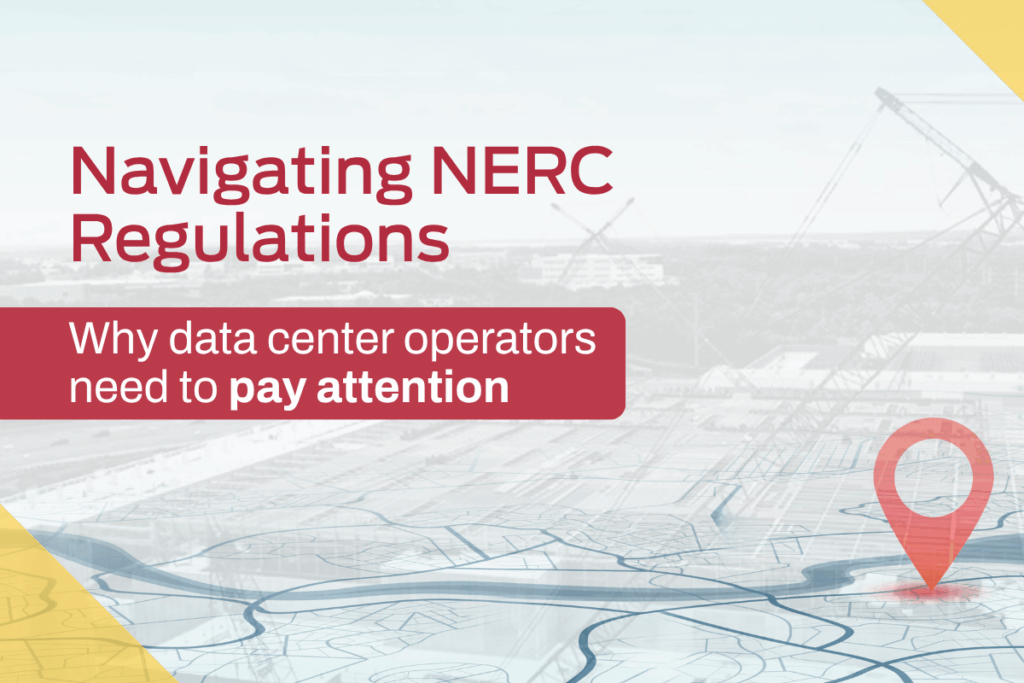As data centers evolve into critical grid players, understanding and navigating regulatory environments—especially those governed by the North American Electric Reliability Corporation (NERC)—has become essential. As data centers increasingly attract regulatory attention, it’s crucial for operators and developers to proactively manage data center interconnection and NERC compliance to ensure reliability and resilience.

What is NERC, and why does it matter?
NERC operates under the authority of the Federal Energy Regulatory Commission (FERC) and plays a pivotal role in maintaining grid reliability. Established through the Energy Policy Act of 2005, NERC regulates energy suppliers, grid operators, and planners to ensure system stability and prevent widespread outages.
Recent grid events and data centers
Recent events have highlighted how data centers, as large, energy-intensive facilities, significantly impact grid reliability. Events such as grid disruptions and demand surges have brought data centers into NERC’s spotlight. As a result, data center operators now face closer scrutiny from NERC’s Large Loads Task Force, which assesses the risks posed by substantial power consumers to grid reliability.
What’s new in 2025 (why this suddenly matters more)
NERC just escalated “large load” risk. In July 2025, NERC’s Large Loads Task Force (LLTF) published a white paper profiling data centers (including AI/crypto) as voltage‑sensitive, power‑electronic loads that can swing megawatts in milliseconds and disconnect during disturbances. In September 2025, NERC issued a Level 2 Industry Recommendation (Alert) instructing utilities, planning entities and Balancing Authorities (BAs) to tighten interconnection studies, commissioning, and operations for large loads—explicitly naming data centers—with acknowledgment by Sept 16, 2025 and reporting by Jan 28, 2026. Even if your company isn’t NERC‑registered, expect your Transmission Owner or Balancing Authority (TO/BA) to require More rigorous data, models, and operational behaviors.
Why the urgency: NERC’s incident review analyzed events where ~1,500 MW of data center load dropped off the grid during a normally‑cleared fault, driving frequency overshoot and voltage issues. Operators report more of these near‑misses as hyperscale campuses cluster. Expect new ride‑through expectations and tighter coordination asks.
Implications for data center operators and NERC compliance
NERC’s attention translates into heightened responsibilities and potential liabilities for data center operators. To effectively navigate these challenges, operators should ensure that data center interconnection and NERC compliance are addressed early in project design and operational planning:
- Understand their classification as “functional entities” within NERC’s framework.
- Anticipate regulatory impacts by engaging proactively with NERC’s regional entities.
- Adopt reliability-enhancing measures, including partnering with Balancing Authorities (BAs) to better control power cons
Do data centers have to register with NERC?
Most data centers are not NERC‑registered today. However, if your campus owns BES‑connected generation or storage (≥100 kV) with units >20 MVA or ≥75 MVA aggregate, you can trigger Bulk Electric System inclusion and potential GO/GOP registration (and downstream obligations like PRC/MOD/VAR—and possibly CIP). Engage early if on‑site BESS or generation could export at transmission voltage.
Plus side: Practices vary by region, but if you own and operate the high‑voltage substation and are registered for the applicable NERC functions (typically Transmission Owner/Planner), you gain direct control over station switching (e.g., paralleling transmission lines or transformers) and can fully leverage more resilient topologies (breaker‑and‑a‑half, ring bus, or double‑breaker/double‑bus). Note that flexibility does come with accepting the associated compliance responsibilities.
Relevant standards for data center interconnection and NERC compliance
FAC‑001‑4 / FAC‑002‑4 – Transmission Owner/Planner interconnection requirements and studies (2025 refresh). Ask your TO for their latest FAC‑001 posting and how they interpret “qualified changes” that retrigger studies.
TOP‑003 / IRO‑010 – the BA/TOP/RC data‑spec standards your telemetry & model submissions will map to.
MOD‑032 / MOD‑033 – model data and model validation requirements that drive your dynamic model scope and event data retention.
EOP‑004 / PRC‑006 – event reporting and under‑frequency load shedding programs you must be compatible with (even if you’re not on UFLS).
Questions to ask your TO/BA on day one
- Step loss tolerance: What maximum step loss (MW) from a single contingency is acceptable at this POI? [NERC]
- Ride-through envelopes: What voltage/frequency ride-through expectations should our UPS/protection target? (Share your template if available.) [NERC]
- Telemetry requirements: What cadence and points satisfy your TOP-003 / IRO-010 specs? [NERC]
- Event recording: Do you require PMU-class event recording at the POI? If so, what sample rates and time sync? [NERC]
- Model validation: Which model formats do you accept (PSSE/PSLF), and how should we submit for MOD-032/033 validation cycles? [NERC]
- Qualified changes: What types of campus modifications retrigger FAC-002 studies?
Proactive compliance and strategic advantage
Proactive compliance with NERC standards offers a strategic advantage. By understanding and preparing for regulatory expectations, data centers can minimize disruptions, reduce compliance-related costs, and enhance their reputational standing in the marketplace. Engaging directly with Balancing Authorities not only supports compliance—it can also help shape faster, more effective grid interconnection outcomes. Proactive data center interconnection and NERC compliance planning strengthens reliability and resilience across every stage of a project.
Conclusion
Navigating NERC regulations is not just about compliance; it’s about adopting a proactive stance that aligns reliability, operational excellence, and strategic advantage. Data centers that embrace this proactive regulatory approach will find themselves better equipped to handle future challenges, benefiting their operations and the broader electrical grid.
Stay tuned for our next post, where we’ll explore the differences between balancing authorities and traditional utilities.
Stay ahead of NERC expectations
At NEI, we help data center developers, utilities, and balancing authorities strengthen interconnection reliability and readiness across every stage of the project lifecycle.
Contact us today to learn how we can help you prepare for evolving NERC expectations and keep your projects connected, compliant, and resilient. →
Related: Data Center Interconnection Series
If you’re just beginning to evaluate interconnection options for your next facility, you’ll want to read: